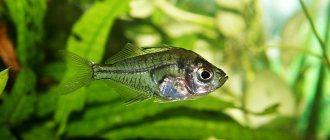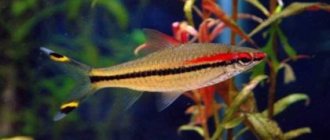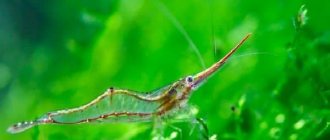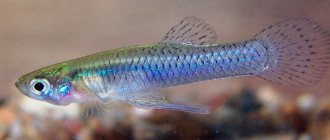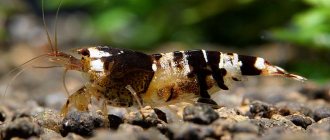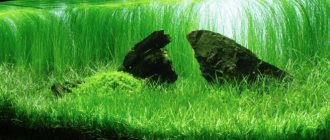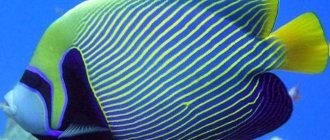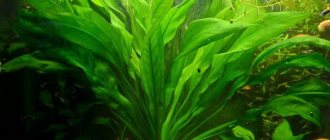Origin
In the early 80s of the twentieth century, the famous nursery of the Danish company “Tropica” received a batch of aquarium plants with a modified form of Echinodorus parviflorus, grown in Singapore and Sri Lanka. In 1985, Czech breeder Karel Rataj described this plant as the variety Echinodorus parviflorus “Tropica”, and since then Tropica has become widespread under this name.
Unlike Echinodorus parviflora, the “Tropica” variety forms a small rosette in the aquarium, approximately 10 cm in size, and looks very advantageous in the foreground. True, he is more capricious and light-loving.
Spreading
Different sources describe the habitat of tropical Echinodorus in their own way. Looking through them, you can find information that the plant was brought from Singapore, from the island of Sri Lanka or from the countries of South America. However, it is almost impossible to find this variety in the wild these days.
The discovery of Echinodorus tropica by aquarists is a pure coincidence. In the 80s of the last century, it was brought to a Danish nursery under the guise of another variety - Echinodorus parviflora. According to surviving information, this batch came from Southeast Asia.
Experts immediately noted that the received plants were very different from those they were expecting. But they were captivated by the excellent appearance of the newcomers and their comparative undemanding nature.
The new variety was named after the nursery - “Tropica”. They went on sale with this name.
Appearance
In submersible (water) form it forms a very beautiful, lush rosette. The leaves have a dark green color (the color depends on the lighting and nutrition) and are strongly corrugated. The leaf blades start almost from the base of the plant.
The emersian (above-water) form is distinguished by the presence of a petiole in the leaf and the fact that the leaves acquire a specific marble shade.
From time to time you come across another species of Echinodorus, which is called “Tropica” with a similar “aerial” shape, but in an aquarium it forms a much larger rosette (height 20-30cm), while the leaf petiole is preserved, similar to the emers form, and the rosette itself is not so compact and is not suitable for the foreground.
Paludarium form
Echinodorus tropica is an amphibious plant. Russian and foreign lovers of aquatic fauna are successfully transferring them to live on land. The main rule: act gradually. At the first stage, it is enough to place the sprout so that the tops of several leaves are above the water.
Next, you should reduce the water level. You can do this yourself, taking a small part, or wait for natural evaporation to do its job.
When most of the leaves have adapted to the air, the plant can be transplanted into a pot. Experiments with soil have shown that Echinodorus tropica is able to grow in almost any soil with a high content of peat or sand, special soil for seedlings, etc. Having buried the roots, the plant is watered abundantly, and the pot is placed in a tray with water.
The other method is tougher, but also effective. All leaves are cut off from a young plant taken out of the water, leaving only a cutting about two centimeters long. The root is buried in the soil and ensure that it is always well moistened. After about 10 days, the first “dry” leaf should appear.
Caring for the paludarium form includes frequent, abundant watering and regular spraying.
Plants growing on land differ in appearance from their aquatic relatives. Their leaves acquire an original marble color.
Content
Echinodorus tropicalis is a relatively undemanding aquarium plant. Like all Echinodorus species, this plant will thrive in nutrient-rich soil and clean water. The soil should be fine (1-4 mm) and light; it is advisable to place a good substrate rich in nutrients, including iron, on the bottom of the aquarium, and add soil on top. The total soil level in the aquarium should be at least 5 cm.
Echinodorus tropica will grow in both low light and very high light. In low light conditions it remains very small and compact.
The water parameters also do not matter much; it can be soft water or medium hard; pH: 6 - 8; temperature 21-28 C.
To successfully keep tropical Echinodorus, adding CO2 to the aquarium is not necessary, although this will certainly have a beneficial effect on growth rate and appearance.
The most common problem that can arise when keeping Echinodorus tropica is a lack of iron in the aquarium. This problem can be solved initially by placing an iron-rich substrate on the bottom. You can also add fertilizer tablets or homemade clay balls with fertilizer under the roots of the plant. Additionally, you can add liquid fertilizers to the water.
Echinodorus tropica is a rosette aquarium plant and regular care involves trimming off old, damaged or dying leaves. Be careful not to damage the rhizome when doing this.
Echinodorus tropicalis can grow out of water, but to obtain the paludarium form, you should start by placing the sprouts in moist soil with the leaves out of the water to allow the plant to adapt to new conditions. In this case, the soil should always be kept moist, and the leaves should be regularly moistened with a spray bottle - they should not be allowed to dry out.
Growing and care
Echinodorus tropica is an undemanding plant that can survive most of the owner’s mistakes. However, some are still capable of causing significant damage.
Echinodorus love “fresh” aquariums. The ecosystem in which they are contained must be renewed periodically.
Regular cleaning of the soil using a siphon will help prevent your aquarium from aging. As well as water changes. It is enough to replace a fifth of the total volume weekly.
If the conditions in the aquarium no longer satisfy the requirements of Echinodorus tropica, he will make this clear in the following ways:
- will stop developing;
- the color of the leaves will fade;
- the leaves will curl into a tube and lie on the ground;
- if new leaves appear, they will be significantly different from the rest, they will look like faded needles.
If at least one of these signs appears, you should immediately clean the aquarium and replace the water.
The plant itself should be removed from the soil and carefully examined:
- Diagnosis starts from the root. Healthy roots are pure white. Transparency is a sign of decay. Such areas must be removed with sharp knives or a scalpel.
- At the next stage, the leaves are carefully examined, also removing those that look unhealthy, have inclusions of foreign flowers, and signs of decay. All “wounds” are sprinkled with crushed coal and left in the air for 2-3 hours.
After cleaning, the echinodorus can be returned to its place. The root system is placed in such a way that the cutting sites are, if possible, above the ground. If the measures taken are beneficial, after a few days the plant will produce a new leaf.
Reproduction
In aquarium conditions it rarely reproduces and produces almost no inflorescences. Although sometimes with good growth there are spontaneous divisions of the rhizome.
In its terrestrial form, Echinodorus grows quickly and often forms inflorescences with daughter plants. For commercial purposes, Tropica is propagated only in greenhouses using daughter plants.
Adaptation of the emers form to aquarium conditions in the presence of CO2 and strong light occurs quickly.
ECHINODORUS LARGE LEAF: DESCRIPTION AND CONTENTS.
JAVA MOSS: CARE, CONTENTS, DESCRIPTION, REPRODUCE, PHOTO
AMBULYA: REPRODUCTION, CONTENTS, DESCRIPTION, PHOTO
Water parameters
Echinodorus tropicalis does not require water parameters. It is able to withstand temperature fluctuations and adapt to almost any hardness and acidity. Of course, within acceptable limits.
There are also ideal parameters that will best affect the appearance of the plant, its growth rate and readiness for reproduction. All of them are shown in the table below.
| options | Ideal performance | Acceptable indicators |
| temperature | 22-24°C | 21-28°C |
| acidity | 6.5-7 pH | 6-8 |
| rigidity | 8-10 GH | 5-15 GH |
The main “artificial” varieties of fish
Every consumer should know the main aquaculture fish species in order to be aware of the consequences of their choice for their own health.
Salmonids are undoubtedly the most common and widely available representatives of the fish departments. In nature, salmon lives in the northern part of the Atlantic Ocean (the so-called Atlantic salmon); The lake variety of salmon in Russia inhabits the lakes of the Kola Peninsula and Karelia. However, up to 90% of salmon on the shelves of our stores are imported aquaculture products. Until recently, Norwegian salmon was the leader in terms of import volumes; now it is being replaced by Chilean and Canadian salmon.
Artificially bred trout are fed special feed with the addition of fats, amino acids, vitamins and dyes. Thus, to achieve the traditional scarlet color of meat, the dye canthaxanthin is used, which, by the way, is prohibited by the European Union, but it is added to salmon feed without restrictions. As a result, fish grow to the same size, with “marketable” bright red meat. The problem is that the dyes used in most farmed salmon feeds negatively affect human vision. The whole truth about salmon and trout is here>>
Dorado is a traditional restaurant fish grown in Greece, France and Turkey. To achieve a delicate taste and the signature milky-white color of the meat, this fish is bred in rooms with special light and feed additives are used.
Seabass (aka seabass) is another fish beloved by restaurants for its delicate flavor and tender white meat. Wild sea bass is listed in the Red Book, so it is impossible to buy. All products are grown in fish farms, mainly in Turkey and Greece.
Pangasius (often called “sea tongue”) comes to us from Southeast Asia, where it is artificially bred in the Mekong and Chao Phraya rivers, which have a reputation for being one of the most polluted rivers in the world. For this reason, in many countries in America and Europe, pangasius fillets are not recommended for consumption. In Russia, however, there are no restrictions or prohibitions.
Tilapia is supplied to Russia from Southeast Asian countries, primarily from China, where it is bred in natural and artificial reservoirs. Interestingly, when cultivating tilapia, farmers tend to produce only males, since males grow faster than females. For this purpose, juvenile fish are treated with male sex hormones. Tilapia is an omnivorous fish, which means that with artificial breeding it is difficult to expect high quality nutrition and, as a result, high quality meat. Of course, the manufacturer can kill the causative agents of various intestinal infections by freezing and numerous chemical treatments, but it’s not hard to imagine what quality the resulting product will be.
Sturgeon are also represented by cage products, since fishing for wild sturgeon is prohibited. The populations of beluga, Russian sturgeon, Siberian sturgeon, stellate sturgeon and sterlet are in very poor condition; many species are listed in the Red Book. The reason for this was poaching, hydraulic construction and the development of oil production. When you come across large specimens of sturgeon for sale, you should understand that these are the prey of poachers, and buying them means supporting the illegal fishing of rare species. Sturgeon bred in captivity are small in size. Sturgeon meat is presented on the market in fresh, frozen, smoked and salted forms. But the main reason for sturgeon breeding, of course, is black caviar.
Carp, crucian carp and carp are bred in cages both in Russia and abroad. It is primarily the products of small domestic farmers that reach store shelves. And this is a big plus for the consumer: local producers often do not have enough funds to feed the fish with antibiotics and stimulants. Therefore, in terms of safety, they are head and shoulders above their foreign counterparts.
This also includes seafood - numerous types of shrimp, mussels, oysters, scallops, octopus, cuttlefish, lobsters, lobsters, langoustines, etc. More than 85% of seafood on the Russian market is aquatic and mariculture products. Growing up in captivity and fed with food containing hormones and growth stimulants, antibiotics, dyes and preservatives, seafood poses a real threat to human health, especially if consumed frequently.
Wild seafood is a valuable source of polyunsaturated fatty acids Omega-3 and Omega-6, iodine and taurine. But in the case of artificially grown seafood, talking about health benefits is blasphemy.
Echinodorus by Igor Filippov
Echinodorus Igor Filippov are decorative aquarium plants that have a unique appearance. The leaves of these herbs have a sinusoidal shape. That is why you can come across another name - sinusoid.
The hue of a plant such as green firefly echinodorus changes as it grows larger. Small plants have leaves that are soft green in color. Height reaches 30 cm.
For normal development of vegetation it is required:
- Weekly fluid changes in the reservoir (about 30 percent).
- Liquid temperature is from 24 to 26 degrees.
- Acidity and hardness are at an average level.
- The bottom of the container is filled with nutrient substrate. For normal development of the root system, periodic introduction of nutrients is required.
Diseases
Like any living plants, all types of Echinodorus require the care and attention of the aquarist. When kept in an aquarium, the requirements of a certain variety must be carefully observed, otherwise the roots of the flower will begin to rot, and the leaves will turn yellow or dissolve, beginning to die. The most common diseases of Echinodorus include:
- Fine and contaminated soil, as a result of which the roots of the flower rot. Good roots should be white.
- Turbid water with impurities, which causes plant growth to stop.
- Insufficient light - in this case, the leaves turn yellow and die.
Echinodorus feels great in an aquarium with any types of plants and fish; the catfishes Ancistrus and ampularia snails, which clean the leaves, will be especially useful for the flower. However, in such a neighborhood, it should be taken into account that if the leaves of the plant dissolve, then the fish do not have enough food, or there is an overpopulation problem, due to which the pets gnaw the leaves.
Echinodorus in the aquarium are popular plants that have many fans due to their attractive appearance, variety of species and easy maintenance. With a minimum of effort, you can grow a lush green flower in your home pond, which will become a decoration for the tank.
General information
Echinodorus
Today, Echinodorus is a whole empire of various species, the total number of which exceeds fifty. Moreover, there are also so-called varieties, which are resistant hybrids certified by the International Horticulture Organization.
For example, African varieties differ from South American varieties in the absence of essential oils in the leaves. Just stretch the sheet with your fingers and everything will immediately become clear. Among the family there are babies who barely grow up to five centimeters, and giants more than a meter high. Some species resemble hygrophila in appearance.
The color of the leaves ranges from bright to dark, almost black, shades of green, and in some varieties with dark red, purple or white spots. There are also species with leaves of various shades of red: cherry, golden brown, raspberry, wine, etc. This allows you to create beautiful underwater landscapes using several varieties of this species, which, of course, greatly facilitates the care of the underwater garden, in the thickets of which they scurry bright fish.
Signs of improper cultivation
According to breeders, this plant is not demanding and unpretentious. But the maintenance of Echinodorus Maghreb does not tolerate gross mistakes that may arise due to improper care. The main condition for normal growth is regular washing of the soil and replacement of water. Photos with the names of aquarium plants attract with beauty and simplicity at the same time.
View galleryOtherwise, the aquarium ecosystem will quickly begin to age. These are unsuitable conditions for growth. The first signs indicating improper plant development include:
- growth arrest;
- throwing out needle-shaped leaves;
- the vegetation of the bush becomes smaller.
These signs indicate unsatisfactory growing conditions. It is urgent to eliminate the cause of what is happening, otherwise the plant may die altogether.
Amazonian Echinodorus
The Amazonian species is most popular among experienced and novice aquarists. After all, Amazon has the following advantages:
- Easy care and maintenance.
- This aquarium plant is suitable for planting in tanks that differ in size, volume, and design. They look like bushes, the height of which reaches 40 cm.
- Acceptable temperature range: 16–28 degrees.
- The Amazon endures the blackout. When selecting lighting equipment, you should be guided by what phenotypes are used to fill the containers.
These varieties are planted in an aquarium, the bottom of which is filled with substrate and support. The substrate used includes nutrients and substances. Soil thickness is 4–5 cm. The selection of a suitable option is carried out in a zoological store.
Description
This type of plant is a grass. In nature, it lives in fresh water bodies of South, North and Central America. Under natural conditions, it grows to a height of 20-30 cm. In an artificially created environment, its size is more modest.
Echinodorus tender has the shape of a bush. The maximum height is 10 cm, and the width of the sheets is no more than 5 mm. By growth and development, you can understand whether the conditions in the aquarium are comfortable. If maintained poorly, the aquarium plant becomes smaller.
Due to its miniature size, this species of Echinodorus is perfect for aquascaping. In good conditions it quickly grows into a carpet. You need to monitor the activity of the side shoots and periodically trim them so that they do not fill the entire aquarium. It is also recommended to thin out the carpet occasionally to avoid build-up. In order to ensure rapid growth, you can use a nutrient substrate. This will allow the transplanted plant to quickly take root and begin to reproduce.
Echinodorus tender, depending on the conditions of detention, can change color. One bush can be green, red or even purple!
The influence of pH on the growth of aquarium plants
The acidity of the water in the aquarium, pH, plays a huge role. And for different types of plants, the optimal pH value is different. The ideal is when the pH in the aquarium is optimal for each plant. But this, of course, cannot be achieved, so I advise you to maintain a certain average pH, optimal for most types of aquarium plants
I consider such a pH range to be between 6 and 7. With some stretch, this range can be stretched to 7.5. Why is it important? The availability of fertilizer nutrients for plants depends on pH. If the pH in your aquarium is lower or higher than normal, then the food for the plants will, simply put, “break through a closed door.” They will not be fully consumed, some will accumulate, some will precipitate. But in the end, the aquarium plants, despite the fact that you pour fertilizer, will show signs of lack of nutrients. If the pH is in the optimal range. The door is open
Plants get their nutrition and look healthy.
Now there is also a very interesting point regarding the role of pH, but a little more complicated. Each nutrient, depending on the pH of the water in the aquarium, has different availability for aquarium plants. Let's look at the slide. What I was talking about. In the interval between 6 and 7, the availability of all nutrients is highest. Therefore, this interval is optimal. And another very important point. Let's say you use a fertilizer of a certain brand and a certain composition. Do you know that this composition will be perceived by plants through the prism of the availability of nutrients? What does it mean? This means that at different pH values, plants will perceive this fertilizer as completely different fertilizers. You change the pH, let's say it was 7, but it became 6, and for your plants it is actually the same as if you changed the fertilizer. I don't want to say that you need to stabilize the pH at one value and religiously hold it. There will always be pH fluctuations throughout the day. But at least you need to know about this and take it into account if any problems arise in an aquarium with plants and not run to look for some additional fertilizers. You just need to figure out the pH of the water in the aquarium. It may have dropped or grown unnoticed.
Echinodorus cordifolius "Tropica Marble Queen"
A powerful plant with heart-shaped or ovate leaves in a rosette of light green color, covered with spots (resulting from a viral infection). Spotting when kept underwater weakens over time. Reaches fifty (and higher) centimeters. Requires large volume and intense lighting. Water - from high to medium hardness, slightly alkaline. Washed sand is suitable as a substrate. Temperature 22-26 degrees. It grows quite quickly, is undemanding in care, and forms emergent leaves. Planted in the center or in the background as a tapeworm.
Echinodorus "Rose"
Other species of the genus Echinodorus
- Echinodorus spadeleaf
- Echinodorus Asherson
- Echinodorus Blehera or Yarrow
- Echinodorus goremana
- Echinodorus Amazonis
- Echinodorus major or Bartha
- Echinodorus vertical
- Echinodorus horizontalis
- Echinodorus speckled
- Echinodorus latifolius
- Echinodorus tender or Echinodorus herbaceous
- Echinodorus osiris
- Echinodorus acuminata
- Echinodorus sellovianus
- Echinodorus cordifolia
- Echinodorus angustifolia
General information
Echinodorus is a genus of plants in the Chastukhov family. Many aquarists place Echinodorus in the aquarium, fascinated by the beauty of the underwater flower. The plant genus includes many varieties, including annuals and perennials, growing above and below water.
Many species of Echinodorus are cultivated, since it is not difficult to grow plants in home artificial reservoirs - the flowers easily adapt and grow in liquids with different indicators. General recommendations for keeping members of the family in an aquarium:
- Bright, intense lighting.
- Clean, clear water, which should not be exposed to direct sunlight.
- Installing a filter and aerator to purify water and saturate the liquid with oxygen.
- Certain species require additional fertilizing with fertilizers.
- Care - aquarium Echinodorus plants are regularly trimmed and overgrown parts are removed.
Editorial: Barbus butterfly
Cultivation
When keeping a plant in an aquarium, the optimal temperature is 22-28 °C; when it drops to 22 °C, growth slows down significantly. Water should be of medium hardness (6-12 German degrees), from slightly alkaline to neutral (7-8.5). Soft acidic water is unacceptable for the plant; it quickly dies in it. Periodic replacement of part of the water is advisable. Turbid water is undesirable, since the turbidity settling on the leaves harms Echinodorus. During the flowering period, it is advisable to apply mineral fertilizers and microelements. The lighting should be very bright, but diffused. With side lighting, the bush becomes looser and forms daughter plants. Natural light makes the color of the plant more saturated. Daylight hours should be 12-14 hours. The soil should be nutritious and consist of a mixture of coarse sand with small pebbles with an admixture of clay, peat and charcoal and be abundantly silted.
In the aquarium, the large Echinodorus reproduces mainly vegetatively, forming daughter plants on the rhizome. The plant produces flower shoots several times a year, but rarely produces full-fledged seeds. The formation of several flower shoots at once can lead to the death of the plant. Their formation can be helped by artificial pollination with a brush; the fruits are removed after they are fully ripe, the seeds are slightly dried for 1-2 months, sown in sand covered with a thin layer of water and germinated at a temperature of about 28 ° C. If the fruits do not set, then daughter plants are formed on the submerged flower arrow, which can be separated after they have formed 4-5 leaves.
Supreme Landscaper
Among aquarium plants, the supreme gardener deserves special attention. After all, their leaves are distinguished by a bright emerald hue. The leaves are distinguished by increased density and the presence of veins.
The Supreme Landscaper is easy to keep. To fill the bottom, a substrate with nutrients and useful components is used.
For the normal development of the plant, the supreme gardener requires a voluminous tank, which has a large area. The lid of the container must be supplemented with lighting equipment. The duration of daylight hours is 10–12 hours.
The supreme gardener rarely produces the arrows that are necessary for normal propagation.
The height of the supreme gardener plant reaches 25–30 cm. It grows in the form of a bush, so the central part of the aquarium is allocated for its placement.
Plant characteristics
Echinodorus is characterized by vegetative reproduction.
In nature, representatives of the genus grow in the water column, along the banks of reservoirs, and in wetlands.
Morphological description of the genus Echinodorus:
- The leaves form a dense or loose rosette. The veins are clearly visible on the outer side.
- The flowers are bisexual, 0.7-6 cm in diameter. The corolla consists of 3 petals, painted white, rarely yellow or pink.
- The multi-seeded fruit, 0.5-1 cm in size, breaks into pieces when ripe.
- The underground organs are represented by powerful rhizomes and adventitious roots.
All species of Echinodorus form above-water and underwater forms. They are able to lead a semi-submerged lifestyle, as well as survive on land in drying up water bodies. Plants are most often grown completely submerged. Echinodorus, which grows in the water column, does not bloom and reproduces vegetatively. In some species, vegetative buds are formed in the inflorescences, from which young shoots grow under favorable conditions in a humid environment.
The temperature favorable for echinodorus is +18…+22°C. In aquarium conditions they reproduce vegetatively - by division of rhizomes, suckers, leaf rosettes, and rarely - by seeds. Poor lighting and high acidity of water are unfavorable for growing.
From the editor: The smallest aquarium

